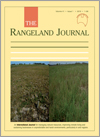RJ18016Rotational grazing and exclosure improves grassland condition of the halophytic steppe in Flooding Pampa (Argentina) compared with continuous grazing
Plant communities growing on saline soils are severely deteriorated by continuous grazing all around the world. This paper shows that not only permanent exclosure, but also rotational grazing may improve vegetation condition and forage value in the halophytic steppes of the Flooding Pampa of Argentina. Such grazing system promotes the replacement of low forage quality species dominant under continuous grazing by species and functional groups of higher forage quality, some of them dominating in less stressed plant communities.





